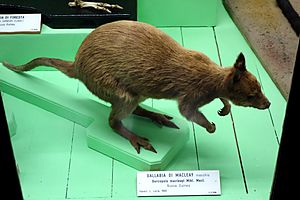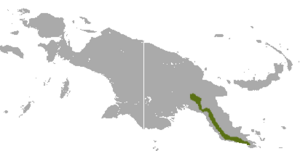Macleay's dorcopsis facts for kids
Quick facts for kids Macleay's dorcopsis |
|
|---|---|
 |
|
| Conservation status | |
| Scientific classification | |
| Genus: |
Dorcopsulus
|
| Species: |
macleayi
|
 |
|
| Macleay's dorcopsis range | |
The Macleay's dorcopsis (Dorcopsulus macleayi) is also called the Papuan dorcopsis or the Papuan forest wallaby. It is a type of marsupial, which is an animal that carries its young in a pouch. This animal belongs to the Macropodidae family, which includes kangaroos and wallabies.
This dorcopsis lives only in Papua New Guinea. Its natural home is in dry forests in warm, wet areas. Experts say it is a "least concern" animal. This means it is not greatly threatened by people destroying its home.
Contents
What is a Macleay's Dorcopsis?
The Macleay's dorcopsis is a small wallaby that lives in forests. It is active mostly at night, which means it is nocturnal. An adult usually weighs about 3 kg (7 lb). Its fur is thick and can be dark brown or black.
One way to tell it apart from a similar animal, D. vanheurni, is by its tail. About two-thirds to three-quarters of the Macleay's dorcopsis's tail is covered with fur. In D. vanheurni, only about half of its tail has fur.
Where Does It Live?
The Macleay's dorcopsis lives only in the southeastern part of the island of New Guinea. You can find it in hilly areas and on the lower parts of mountains. It lives at heights between 1,000 and 1,800 m (3,300 and 5,900 ft) above sea level. It makes its home in both old, untouched forests and forests that have grown back after being disturbed.
How Was It Discovered?
A Russian scientist named Nicholas Miklouho-Maclay was the first to describe this animal. He named it Dorcopsulus macleayi to honor an Australian scientist, William John Macleay. Some scientists used to think it was the same as another species, the small dorcopsis (Dorcopsulus vanheurni). However, in 2005, a scientist named Groves confirmed that it is its own separate species.
Is It Endangered?
The International Union for the Conservation of Nature (IUCN) once thought the Macleay's dorcopsis was a "vulnerable species". But now, they list it as a "least concern" animal. This is because the areas where it lives are hard to reach and are mostly undisturbed. The animal is also quite common in its habitat.
Local people do hunt this species for food, but not so much that it threatens the animal's numbers. Because of these reasons, the Macleay's dorcopsis is not considered to be in danger right now.


